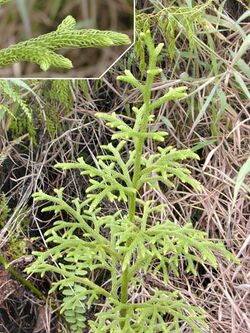Biology:Palhinhaea cernua
| Palhinhaea cernua | |
|---|---|

| |
| Scientific classification | |
| Kingdom: | Plantae |
| Clade: | Tracheophytes |
| Clade: | Lycophytes |
| Class: | Lycopodiopsida |
| Order: | Lycopodiales |
| Family: | Lycopodiaceae |
| Genus: | Palhinhaea |
| Species: | P. cernua
|
| Binomial name | |
| Palhinhaea cernua | |
| Synonyms[2] | |
| |
Palhinhaea cernua, synonym Lycopodiella cernua and Lycopodium cernuum, is a plant in the family Lycopodiaceae,[2] commonly known as the staghorn clubmoss.[3] The Hawaiian name for the plant is wāwaeʻiole, or "rat's foot". It has a substantial number of scientific synonyms in several genera. The genus Palhinhaea is accepted in the Pteridophyte Phylogeny Group classification of 2016 (PPG I),[4] but not in other classifications which submerge the genus in Lycopodiella.[5] It is the largest of the clubmosses, having rhizomes up to 5 m (16 ft) in length, with leafy uprights up to 2.5 m (8 ft 2 in) in height.[6]
Distribution
Palhinhaea cernua is a widespread pan-tropical species, found mostly at higher elevations in subtropical mountain climates of tropical Africa, Asia, the Pacific Islands and the Neotropics. In Europe, it is found in the Azores (where it is possibly native) and formerly on Madeira. It has been introduced in continental Portugal (Valongo), Sicily and Malta.[1]
It favors bog environments.
Palhinhaea cernua is sometimes cultivated.
References
- ↑ 1.0 1.1 Christenhusz, M., Bento Elias, R., Dyer, R., Ivanenko, Y., Rouhan, G., Rumsey, F. & Väre, H. (2017). "Palhinhaea cernua". IUCN Red List of Threatened Species 2017: e.T83571087A83571205. https://www.iucnredlist.org/species/83571087/83571205. Retrieved 23 August 2021.
- ↑ 2.0 2.1 2.2 Hassler, Michael; Schmitt, Bernd (November 2019), "Palhinhaea cernua", Checklist of Ferns and Lycophytes of the World, 8.11, https://worldplants.webarchiv.kit.edu/ferns/, retrieved 2019-12-06
- ↑ "Lycopodiella cernua". Natural Resources Conservation Service PLANTS Database. USDA. https://plants.usda.gov/core/profile?symbol=LYCE2. Retrieved 26 July 2016.
- ↑ PPG I (2016). "A community-derived classification for extant lycophytes and ferns". Journal of Systematics and Evolution 54 (6): 563–603. doi:10.1111/jse.12229.
- ↑ Christenhusz, Maarten J.M.; Chase, Mark W. (2014). "Trends and concepts in fern classification". Annals of Botany 113 (9): 571–594. doi:10.1093/aob/mct299. PMID 24532607.
- ↑ Andrews, S.B. (1990). Ferns of Queensland. Brisbane: Queensland Dept. of Primary Industries. p. 226.
Further reading
- Cook Islands Biodiversity Database: http://cookislands.bishopmuseum.org/species.asp?id=6348
- In efloras: http://www.efloras.org/florataxon.aspx?flora_id=12&taxon_id=242330770
Wikidata ☰ {{{from}}} entry
 |



